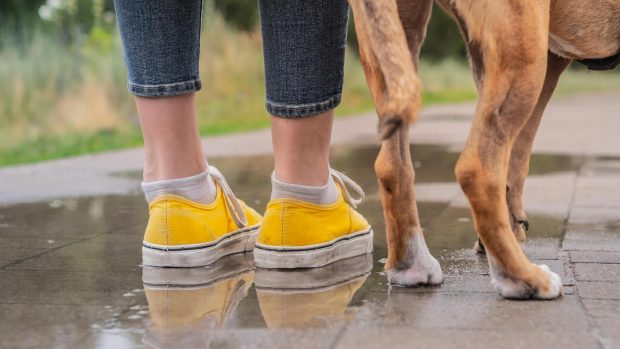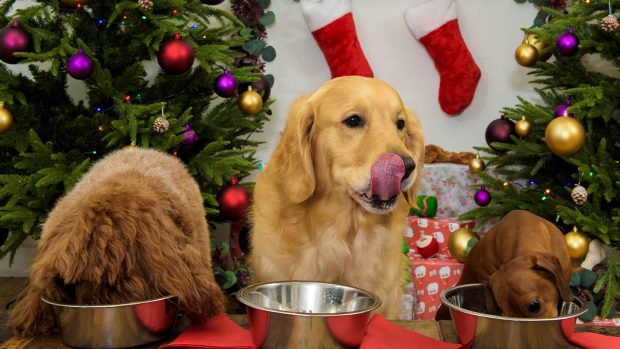If you love an athletic dog with plenty of class but a bit of rough round the edges, then the deerhound fits the bill. This statuesque sighthound is known for its large size, elegant appearance, and background coursing deer in Scotland. The breed has its origins some 500 years ago, when it was used to course wolves and was known as the Scottish Wolfdog. However, as the wolf population declined and this rough-coated greyhound-type breed was used for deer-coursing instead, gaining the name deerhound. They are similar in appearance to other breeds with comparable characteristics, such as the Irish Wolfhound. In the US, they are known as the Scottish Deerhound.
Although deerhounds were developed to course deer for many miles over the wild Scottish terrain, they are appealing as pet dogs, too. Their gentle and friendly nature makes them ideal companions, especially in family settings. Despite their large size, they are typically wonderful with children and other pets. Their loyalty and devotion to their owners create strong bonds, providing a sense of companionship.
Physically speaking, they are known for their elegant and regal appearance. With long legs and a shaggy coat, they possess a graceful yet rugged charm, coupled with a calm and dignified demeanour. Surprisingly, for a dog with deep pockets of stamina and the power to pull down a stag, they are not overly active indoors, often described as “couch potatoes”, making them well-suited for a relaxed home environment.
The Irish Wolfhound and the deerhound are often confused, but there are ways of telling them apart. The Irish Wolfhound is taller and more muscular. Both have wiry, hairy tails, but while the Irish Wolfhound’s is long and slightly curved, the deerhound’s is long and tapering, almost to the ground. Finally, the ears differ. The Irish Wolfhound, according to the breed standard, has small, greyhound-type ears, while the deerhound’s are set higher and fold back at rest.

The rugged coat of the deerhound gives them a toughness in harsh conditions in the Scottish climate where the breed was developed
Deerhound dog breed: fact file
Kennel Club breed group: hound
Size: large
Daily exercise: more than two hours
Coat: medium (wiry), shedding
Colours: essentially shades of grey – black & grey, blue brindle, blue grey, brindle, dark brindle, dark grey, grey and grey brindle. Eyes are dark brown or hazel.
Lifespan: more than 10 years
Bark: infrequent; it is rare for a deerhound to bark much, even when a stranger is at the door
History: for over half a millennium, large, rough-coated dogs similar to greyhounds have been known in Scotland. What is now officially the deerhound breed was initially called the Scottish Wolfdog, but as the wolf population diminished and the breed was increasingly used to course deer, it changed to deerhound. The Victorians revived the breed and it remains much-loved to this day for its athletic, elegance and gentle temperament. The deerhound, however, does feature on the Kennel Club’s list of endangered dog breeds.
Distinctive features: their look is of a rough-coated, shaggy greyhound, but larger and more substantial. Dignified but powerful, noble and majestic.
Temperament: gentle and friendly, with a lovely temperament. Never suspicious, nervous or aggressive.
Things to consider: as one of the largest hound breeds, one of the best large-breed puppy foods is recommended to cater for their specific requirements as they develop. They will also require one of the best beds for large dogs to give them space to snooze and relax comfortably.
Training: an obedient breed which is typically a joy to train because they love to please.

The Complete Guide To Scottish Deerhounds | Amazon
If you have just purchased a Scottish Deerhound or want to train your little one, this guide will teach you how to raise your Scottish Deerhound obedient, healthy and happy.

Wisdom Panel DNA collection kit | Amazon
Find out what breed your dog is with this kit that gives you everything you need to collect your dogs DNA and send it off. Includes a pre-paid envelope if you’re in the UK.
You may also enjoy reading…

Meet 7 of the largest dog breeds on the planet

Stretch and snooze: the best beds for large dogs

All about the bloodhound

Did you know: a hound is a dog, but not all dogs are hounds

It’s playtime! How to keep puppy entertained at home

Subscribe to Horse & Hound magazine today – and enjoy unlimited website access all year round
Horse & Hound magazine, out every Thursday, is packed with all the latest news and reports, as well as interviews, specials, nostalgia, vet and training advice. Find how you can enjoy the magazine delivered to your door every week, plus options to upgrade your subscription to access our online service that brings you breaking news and reports as well as other benefits.




